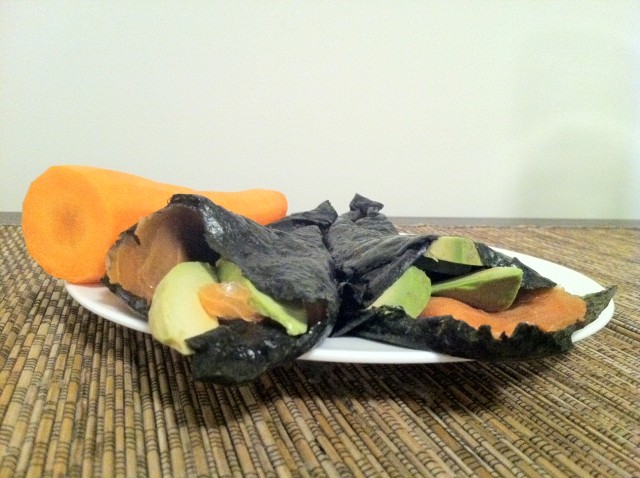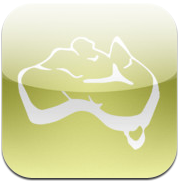Iodine rich (and ugly) breakfast hand rolls
Posted by Tanja on Mar 9, 2012 in Paleo breakfast, Real Food | Comments Off
Are you getting enough iodine?
Iodine is essential for thyroid function and removing processed food and salt from your diet pretty much eliminates your regular sources of it. Seafood is a good source of iodine, so if you regularly feast on seafood, you should be fine.
“[S]ince you’re no longer eating processed food rich in iodized salt, which is where many people get their iodine, you may be missing out. And if you’ve switched from iodized table salt to unrefined sea salt – as many Primal eaters do – you’ve just removed another rich source of iodine in their diets. Instead of popping iodine or going back on the junk food, just eat foods rich in iodine. Seaweed, shellfish, and other seafood, seeing as how they spend most of their waking lives fully immersed in iodine-rich sea water, are excellent sources of iodine.
Vegetables and the animals that eat them can also be good sources of iodine, but if the soil is iodine-depleted, so is the food that grows and eats there. The sea will most likely always be a good source.”
I’ve also discovered that some of our kitchen stables (namely cabbage & cauliflower) might actually be amplifying the lack of iodine and it’s effect on thyroid function.
“[S]ulfur-rich cruciferous veggies, but they can also act as goitrogenic inhibitors of thyroid function. Goitrogens interfere with iodine uptake by the thyroid, so excessive intake of cabbage, cauliflower, and other cruciferous vegetables might necessitate a bit more iodine in the diet.”
Read more: http://www.marksdailyapple.com/do-perfect-foods-exist/#ixzz1oZI5VZ3i
If you have any reason to doubt your current iodine intake levels and if you’re exhibiting symptoms of hypothyroidism, it might be a good idea to see a GP and get a thyroid panel done as well as your iodine levels tested.
“Early symptoms:
- Being more sensitive to cold
- Constipation
- Depression
- Fatigue or feeling slowed down
- Heavier menstrual periods
- Joint or muscle pain
- Paleness or dry skin
- Thin, brittle hair or fingernails
- Weakness
- Weight gain (unintentional)
Late symptoms, if left untreated:
- Decreased taste and smell
- Hoarseness
- Puffy face, hands, and feet
- Slow speech
- Thickening of the skin
- Thinning of eyebrows”
Good sources of iodine:
As Australian soil is depleted of minerals such as iodine, we wouldn’t be getting significant amounts of iodine out of vegetables and animals. Out best bet is the sea.
Seaweed is a great source of iodine, but in the post-Fukushima world, not necessarily the safest option. Most of the seaweed sold in Australia come from around the Fukushima area, so I wouldn’t necessarily recommend upping your seaweed intake.
Fortunately there are other options: Australian kelp, Canadian dulse and New Zealand spirulina are great options to use instead of seaweed.
According to my GP (I finally found one fully versed in the wonders of paleo lifestyle!) the most concentrated one out of the lot is Australian kelp. It can be sprinkled onto soups and salads in small amounts - as it’s so nutrient dense, you don’t need much of it.
If you like making smoothies, spirulina is an excellent supplement to use - as long as you don’t mind the taste that is.
Then again, if you like snacking on ‘seaweedy’ things, Canadian dulse might be a good option for you. It’s a bit more moist and in apparently makes for a great snack.
Personally I’ll be going with either dulse or kelp (which ever I happen to locate first to be honest). In the meanwhile, I’ve got some seaweed - the health food store owner promised she received the order before the Fukushima incident - that I made these rather ugly hand rolls out of. Not necessarily visually appealing, but it was actually quite tasty.
Quick and simple: wrap some smoked salmon and avocado in a sheet of seaweed and you’re good to go!

